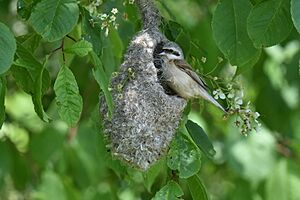Chinese penduline tit facts for kids
Quick facts for kids Chinese penduline tit |
|
|---|---|
 |
|
| With nest, Primorsky Krai, Russia | |
| Conservation status | |
| Scientific classification | |
| Genus: |
Remiz
|
| Species: |
consobrinus
|
The Chinese penduline tit (Remiz consobrinus) is a small bird that belongs to the Remizidae family. It was first described by Robert Swinhoe in 1870. You can find this bird in countries like China, Japan, North Korea, South Korea, and Russia.
There are 10 different types of birds in the Remizidae family. These birds look a bit like regular tits, but they build special hanging nests. They like to live in open fields and wet areas. Both male and female Chinese penduline tits look similar, and they have sharp beaks.
Contents
What Does It Look Like?
The Chinese penduline tit is a small bird, about 11 cm (4.3 inches) long. It has light-colored feathers and a thin, pointed beak. These birds often fly around in groups of 10 to 20. They are usually found in areas with tall reeds.
Male vs. Female
- Male: Males have a grey head and the back of their neck. They have a black mask around their eyes, which has a white edge. Their back, part of their neck, and some wing feathers are a reddish-brown color. Their wings are dark, and their tail is black when they fly. Their belly is whitish with some light brown marks.
- Female: Females have a brown mask around their eyes. Their upper body feathers are browner and do not have the reddish-brown color seen in males.
Where Does It Live and What Does It Do?
The Chinese penduline tit lives in Asia, especially in northern China. It loves places with lots of reeds and marshes. You can also find it in farm fields and wetlands with ponds. These birds often hang out in groups of 10 to 20.
When winter comes, these birds fly south to warmer parts of China.
What Does It Eat?
The Chinese penduline tit is an insect-eater. It mostly eats insects, their larvae, spiders, and caterpillars. Sometimes, especially in winter, it will also eat small seeds.
This bird is very good at climbing. It can hang upside down by one leg and use its other leg to grab food.
What Does Its Voice Sound Like?
The Chinese penduline tit makes a very thin, long sound. It sounds like 'tseeoo' or 'sseeoo'.
How Does It Reproduce?
The male Chinese penduline tit chooses a tree for the nest. The nest is usually built high up, between 3 to 15 meters (10 to 50 feet) off the ground.
The Amazing Nest
The nest of the Chinese penduline tit is truly a work of art! It looks like a pear-shaped bag or purse. The nest has a long, tube-like entrance on the side.
After the female finishes making the inside of the nest cozy, she usually lays between 5 and 10 eggs. She sits on the eggs by herself for about 12 to 15 days until they hatch.
After the Chicks Hatch
Once the young birds are ready to fly, the nest might look a bit squashed or fall apart. The young birds will still come back to the nest to sleep for another 15 to 20 days. After that, they leave the nest for good.
Is It Safe?
The number of Chinese penduline tits is actually growing! Because of this, the IUCN considers it a "least concern" species. This means they are not worried about it becoming endangered anytime soon.


